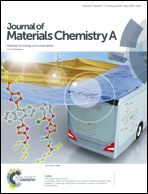Novel dual superlyophobic materials in water–oil systems: under oil magneto-fluid transportation and oil–water separation†
Abstract
Materials with superhydrophobicity under oil or superoleophobicity underwater have attracted great attention due to their widespread applications in non-loss liquid transportation and oil–water separation. However, it is a big challenge to prepare dual superlyophobic materials in oil–water systems (simultaneously superhydrophobic under oil and superoleophobic underwater) due to the thermodynamic unfavorable state of dual superlyophobicity. In this work, we fabricated dual superlyophobic polyimide films and a stainless steel mesh using a simple one-step approach. They can maintain their superlyophobicity in hexane–water, petroleum ether–water and dichloromethane–water systems, even if after oil immersion for 2 h, or without additional surface modifications when the oil–water system is changed. The dual superlyophobic polyimide film can be utilized as a non-loss magneto-liquid transportation under oil, and dual superlyophobic stainless steel mesh can be used to separate hexane–water, petroleum ether–water and dichloromethane–water mixtures with separation efficiencies greater than 99.90%.



 Please wait while we load your content...
Please wait while we load your content...